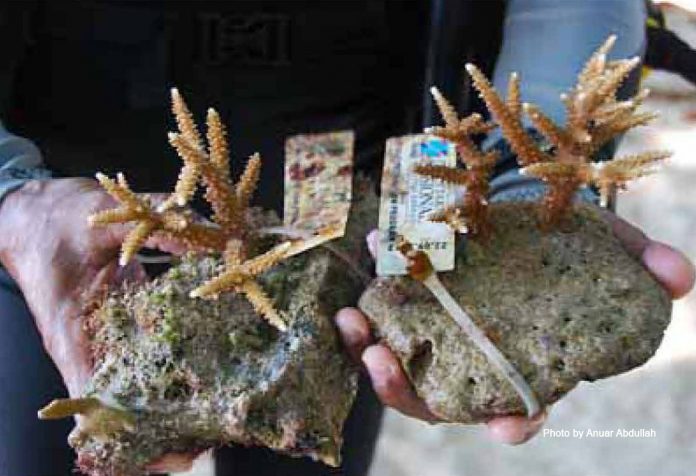Greenhouse gases are wreaking havoc on land and ocean temperatures all over the Earth. The rise in sea and ocean temperatures has caused widespread coral bleaching all over the world. Anuar Abdullah reveals the top 5 reasons why coral communities are dying or flourishing.

The killing of too many plant-feeding fish leads to overgrowth of plants, which smother corals, threatening their survival[/icon_timeline_item][icon_timeline_item time_title=”APPROPRIATE DEPTHS” title_font_style=”font-weight:bold;” title_font_color=”#0066bf”]
Relatively shallow (<27 metres), clear waters, allowing photosynthesis; deep-sea corals flourish in dark waters at 6,000 metres[/icon_timeline_item][icon_timeline_item time_title=”SEWAGE AND INDUSTRIAL POLLUTION” title_font_style=”font-weight:bold;” desc_font_color=”#000000″ title_font_color=”#dd0000″]
Cuts out sunlight, giving rise to germs and disease; poisons corals directly, killing them
off quickly[/icon_timeline_item][icon_timeline_item time_title=”NARROW RANGE OF TEMPERATURES” title_font_style=”font-weight:bold;” title_font_color=”#0066bf”]
Tropical and subtropical waters between 20 and 30°C; deep-sea corals survive without sunlight on underwater peaks called seamounts[/icon_timeline_item][icon_timeline_item time_title=”SEDIMENT DISTURBANCES” title_font_style=”font-weight:bold;” title_font_color=”#dd0000″]
Corals covered with sediment will succumb swiftly to tissue loss and death; Fungiid corals can actively shed sediment buildup by inflating and deflating rapidly[/icon_timeline_item][icon_timeline_item time_title=”STABLE CARBON DIOXIDE LEVELS” title_font_style=”font-weight:bold;” title_font_color=”#0066bf”]
Increasing carbon dioxide levels changes water chemistry, preventing corals from building their skeletons; also slows down growth and rate of regeneration[/icon_timeline_item][icon_timeline_item time_title=”DREDGING” title_font_style=”font-weight:bold;” title_font_color=”#dd0000″]
Dredging-generated sediments smother corals[/icon_timeline_item][icon_timeline_item time_title=”STABLE WATER CONDITIONS” title_font_style=”font-weight:bold;” title_font_color=”#0066bf”]
Require salinity between 34 and 37 parts per 1,000; they do well away from freshwater run-off[/icon_timeline_item][icon_timeline_item time_title=”CLIMATE CHANGE” title_font_style=”font-weight:bold;” title_font_color=”#dd0000″]
Overly warm waters cause coral bleaching, making them susceptible to disease, which can lead to large-scale reef die-off; stronger storms harm coral reefs, translating into less time for sensitive habitats to recover[/icon_timeline_item][icon_timeline_item time_title=”MINIMAL HUMAN INTERFERENCE” title_font_style=”font-weight:bold;” title_font_color=”#0066bf”]
Need we say more?[/icon_timeline_item][/icon_timeline]
Check out the rest of this article in Asian Geographic No.111 Issue 3/2015 ) here or download a digital copy here











